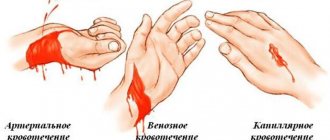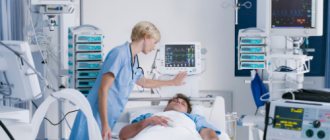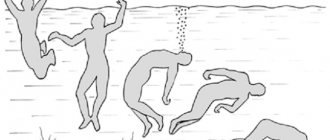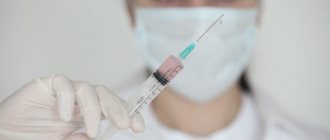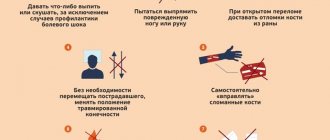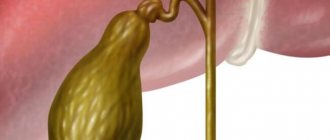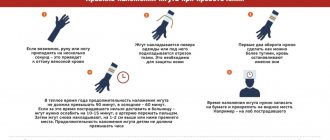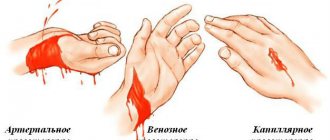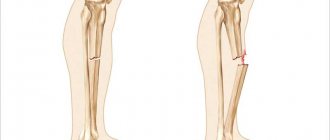Hemorrhagic shock (HS) is a critical condition of the body associated with acute blood loss, resulting in a crisis of macro- and microcirculation, a syndrome of multiple organ and multisystem failure. From a pathophysiological point of view, this is a crisis of microcirculation, its inability to ensure adequate tissue metabolism, satisfy the tissue need for oxygen, energy products, and remove toxic metabolic products.
The body of a healthy person can restore blood loss of up to 20% of the bcc (approximately 1000 ml) due to autohemodilution and redistribution of blood in the vascular bed. With blood loss of more than 20-25%, these mechanisms can eliminate the deficit of blood volume. With massive blood loss, persistent vasoconstriction remains the body’s leading “protective” reaction, and therefore normal or close to normal blood pressure is maintained, blood supply to the brain and heart is provided (centralization of blood circulation), but at the expense of weakening blood flow in the muscles of internal organs, including kidneys, lungs, liver.
Long-term stable vasoconstriction, as a protective reaction of the body at first, maintains blood pressure within certain limits for some time, and later, with the progression of shock and in the absence of adequate therapy, contributes to the consistent development of severe microcirculation disorders, the formation of “shock” organs and the development of acute renal failure and other pathological conditions.
The severity and speed of disorders during HS depends on the duration of arterial hypotension and the ascending state of organs and systems. With ascending hypovolemia, short-term hypoxia during labor leads to shock, as it is a trigger for impaired hemostasis.
What is shock?
Shock or state of shock - that is, literally “blow, shock” - is a dangerous pathological process that develops in response to extreme shocks of both a physical and emotional nature. Shock is accompanied by a progressive disruption of the vital functions of the nervous system, blood circulation, respiration, metabolism and some others. In essence, this is a breakdown of the body’s compensatory reactions in response to damage. Monitoring of the course of shock should be carried out in intensive care units and intensive care units. But before the victim comes under the supervision of doctors, he should be given first aid.
GBUZ NO "Pavlovsk Central District Hospital"
Emergency care for acute life-threatening conditions
In our country, up to 80% of deaths occur outside of medical organizations - at home, at work, in the country, in public and other places. Most of them occur suddenly or by the mechanism of sudden death. Statistics show that many patients (or their relatives) call an emergency doctor late, which reduces the likelihood of rescue.
By mastering the necessary first aid skills in the form of self- or mutual assistance (on the part of people surrounding a person who finds himself in such a critical condition), in most cases the patient’s life can be saved.
Often, up to 30-50%, a life-threatening complication with a dangerous fatal outcome may be the first and last manifestation of these diseases (complications).
FIRST AID for a heart attack
Characteristic signs (symptoms) of a heart attack (myocardial infarction):
• sudden (paroxysmal) pressing, squeezing, burning, aching pain in the chest (behind the sternum) lasting more than 5 minutes;
• similar pains are often observed in the left shoulder (forearm), left shoulder blade, left half of the neck and lower jaw, both shoulders, both arms, the lower part of the sternum along with the upper abdomen;
• lack of air, shortness of breath, severe weakness, cold sweat, nausea often occur together, sometimes follow or precede discomfort/pain in the chest; often these manifestations of the disease develop against the background of physical or psycho-emotional stress, but more often with some interval after them.
Uncharacteristic signs that are often confused with a heart attack:
• stabbing, cutting, pulsating, boring, constant aching pain for many hours and not changing its intensity in the heart area or in a specific clearly defined area of the chest
Algorithm of emergency actions in case of a heart attack (advice to the patient) - a reminder for the patient
If you or someone else suddenly has the above characteristic signs of a heart attack, even with weak or moderate intensity, which last more than 5 minutes, do not hesitate, immediately call an ambulance team. Do not wait more than 10 minutes - in such a situation it is life-threatening.
Remember that being intoxicated in this life-threatening situation is not a reasonable excuse for delaying calling an ambulance. If you have symptoms of a heart attack and there is no way to call an ambulance, then ask someone to take you to the hospital - this is the only right decision. Never drive yourself unless you have no other choice.
In the most optimal scenario, if a heart attack occurs, you must follow the instructions received from your attending physician; if there are no such instructions, then you must act according to the following algorithm:
• Immediately after an attack occurs, sit down (preferably in a chair with armrests) or lie down in bed with the head of the bed raised, take 0.25 g of acetylsalicylic acid (aspirin) (chew the tablet, swallow) and 0.5 mg of nitroglycerin (spray one inhalation dose into the cavity mouth while holding your breath, place one tablet/capsule under the tongue, first bite the capsule, do not swallow); free your neck and provide fresh air (open the vents or windows).
• If after 5-7 min. After taking acetylsalicylic acid (aspirin) and nitroglycerin, pain persists, it is imperative (life-saving) to call an ambulance and take nitroglycerin a second time.
• If pain persists 10 minutes after taking the second dose of nitroglycerin, it is necessary to take nitroglycerin a third time.
• If after the first or subsequent doses of nitroglycerin there is severe weakness, sweating, shortness of breath, you need to lie down, raise your legs (on a bolster, etc.), drink 1 glass of water and then, as with a severe headache, do not take nitroglycerin.
• If the patient has previously taken medications that lower cholesterol levels in the blood from the statin group (simvastatin, lovastatin, fluvastatin, pravastatin, atorvastatin, rosuvoastatin), give the patient his usual daily dose and take the drug with you to the hospital.
Attention ! A patient with a heart attack is strictly forbidden to get up, walk, smoke or eat until the doctor’s special permission;
You should not take aspirin (acetylsalicylic acid) if you are intolerant to it (allergic reactions), as well as with obvious or worsening peptic ulcers of the stomach and duodenum;
Nitroglycerin should not be taken if there is severe weakness, sweating, or if there is severe headache, dizziness, or acute impairment of vision, speech, or coordination of movements.
FIRST AID for acute cerebrovascular accident
The main signs (symptoms) of acute cerebrovascular accident:
• numbness, weakness, “disobedience” or paralysis (immobilization) of an arm, leg, half of the body, distortion of the face and/or drooling on one side;
• speech disorders (difficulties in choosing the right words, understanding speech and reading, slurred and unclear speech, up to complete loss of speech);
• disturbances or loss of vision, double vision, difficulty focusing;
• imbalance and coordination of movements (feelings of “swaying, sinking, body rotation, dizziness”, unsteady gait up to falling);
• unusual severe headache (often after stress or physical exertion);
• confusion or loss of consciousness, uncontrollable urination or bowel movements.
If any of these signs suddenly appear, call an ambulance immediately, even if these manifestations of the disease were observed for only a few minutes
Patient Reminder
1. Call an ambulance immediately, even if these manifestations of the disease were observed for only a few minutes
2. Before the arrival of the emergency medical team:
• If the patient is unconscious, place him on his side, remove removable dentures (food debris, vomit) from the mouth, make sure that the patient is breathing.
• If the victim is conscious, help him to a comfortable sitting or semi-sitting position in a chair or on a bed, placing pillows under his back. Provide fresh air. Unbutton your shirt collar, belt, waistband, and remove tight clothing.
• Measure your blood pressure if its upper level exceeds 220 mmHg. Art., give the patient a drug that lowers blood pressure, which he took before.
• Measure your body temperature. If the temperature is 38° or more, give the patient 1 g of paracetamol (2 tablets of 0.5 g, chew, swallow), (if paracetamol is not available, do not give other antipyretic drugs!).
• Put ice on your forehead and head, you can take food from the freezer, put in waterproof bags and wrapped in a towel.
• If the patient has previously taken medications that lower cholesterol levels in the blood from the statin group (simvastatin, lovastatin, fluvastatin, pravastatin, atorvastatin, rosuvastatin), give the patient the usual daily dose.
• If the victim has difficulty swallowing and saliva drips from his mouth, tilt his head towards the weaker side of the body and blot the dripping saliva with clean tissues.
• If the victim is unable to speak or has slurred speech, reassure and reassure him that the condition is temporary. Hold his hand on the non-paralyzed side, stop him from trying to talk, and don't ask questions that require an answer. Remember that although the victim cannot speak, he is aware of what is happening and hears everything that is said around him.
FIRST AID for hypertensive crisis
Hypertensive crisis is a condition manifested by high blood pressure (BP) (systolic or “upper” blood pressure, usually more than 180 mm Hg; diastolic or “lower” blood pressure - more than 100 mm Hg) and the following main symptoms:
• headache, often in the occipital region, or heaviness and noise in the head;
• flashing “flies”, a veil or a net before the eyes;
• nausea, feeling of exhaustion, overwork, internal tension;
• shortness of breath, weakness, constant monotonous aching pain/discomfort in the heart area, sometimes the appearance or increase of pastiness/swelling of the skin of the face, arms, legs.
Algorithm for emergency actions in case of hypertensive crisis
(advice to the patient) – a reminder for the patient
If symptoms of a hypertensive crisis appear, you must:
• remove bright light, ensure peace, access to fresh air (unbutton your shirt collar, ventilate the room, etc.);
• measure blood pressure (see the method for measuring blood pressure at the end of this section) and if its “upper” level is higher than or equal to 160 mm Hg, you must take an antihypertensive drug previously recommended by your doctor. In the absence of an antihypertensive drug recommended by a doctor or when a blood pressure level is registered above 200 mm Hg. urgently need to call an ambulance.
• before the arrival of emergency medical services, it is necessary, if possible, to sit in a chair with armrests and take a hot foot bath (put your feet in a container of hot water).
Attention! A patient with a hypertensive crisis is prohibited from any sudden movements (suddenly standing up, sitting down, lying down, bending over), pushing hard or any physical activity.
• 40-60 minutes after taking the medicine recommended by the doctor, it is necessary to re-measure blood pressure and if its level has not decreased by 20-30 mm Hg. from the initial state and/or the condition has not improved - urgently call an ambulance.
• If you feel better and your blood pressure decreases, you need to rest (lie in bed with the head of the bed raised) and then contact your local (family) doctor.
When talking with your doctor, you need to clarify which medications you need to take if a hypertensive crisis develops, clearly write down their names, dosage and time sequence (algorithm) for taking them, and also check with your doctor for what manifestations of the disease you need to urgently call an ambulance.
All patients with hypertension need to create an individual mini-first aid kit for a hypertensive crisis and carry it with them at all times, since a hypertensive crisis can develop at any time and anywhere.
FIRST AID for acute heart failure
Acute heart failure (AHF) is a severe pathological condition that develops in patients with various heart diseases and hypertension. This is one of the most common reasons for calling an ambulance and hospitalization of patients, as well as mortality in our country and around the world.
The main manifestations (symptoms) of acute heart failure are:
• heavy, frequent (more than 24 per minute) noisy breathing - shortness of breath, sometimes reaching the level of suffocation, with predominant difficulty in inhaling and a clear increase in shortness of breath and cough in a horizontal position. A sitting position or a lying position with the head of the head raised up alleviates the patient's condition;
• often when breathing, wet, squelching wheezing/sounds, interrupted by coughing, become audible; in the terminal stage, breathing takes on a bubbling character with the appearance of foam at the patient’s mouth;
• characteristic sitting posture of the patient, resting his straight arms on his knees or on the seat (to facilitate breathing)
Acute heart failure can develop very quickly and lead to the death of the patient within 30-60 minutes. In most cases, 6-12 or more hours pass from the first clinical signs to severe manifestations of AHF, but without medical care, the vast majority of patients with AHF die.
Algorithm of emergency actions for acute heart failure
(advice to the patient) – a reminder for the patient
When the above symptoms of AHF appear in patients with hypertension or heart disease (but not the lungs or bronchi), it is necessary:
• call an ambulance
• give the patient a sitting position, preferably in a chair with armrests on which he can lean and engage the intercostal muscles in the act of breathing
• provide physical and psycho-emotional peace and fresh air by ventilating the room
• place your feet in a large container (basin, tank, bucket, etc.) with hot water
• in extremely severe cases, tourniquets are applied to the legs in the groin area, compressing the superficial veins, but not the deep arteries, which reduces blood flow to the heart and thereby facilitates its work
If the patient or the person providing first aid has experience in the use of nitroglycerin, it is prescribed in a dose of 0.4 (0.5) mg (inhalation into the oral cavity is carried out under the root of the tongue, the tablet/capsule is placed under the tongue, the capsule must first be bitten, do not swallow). If the patient’s well-being improves after using nitroglycerin, it is reapplied every 10-15 minutes until the arrival of the emergency medical team. If there is no improvement in the patient’s well-being after the next dose of nitroglycerin, it is no longer used.
Attention! A patient with AHF must exclude all physical activity; it is strictly forbidden to walk, smoke, drink water and take liquid food until special permission from the doctor; Nitroglycerin should not be taken if blood pressure is less than 100 mm Hg. with severe headache, dizziness, acute impairment of vision, speech or coordination of movements.
All patients with hypertension or heart disease with shortness of breath and swelling in the legs should discuss with their doctor what medications should be taken if AHF develops, clearly write down their names, dosage and time sequence (algorithm) for taking them, and also check with the doctor for which manifestations of the disease, it is necessary to urgently call an ambulance.
Each such patient needs to create an individual first aid kit for AHF and constantly have it with him.
FIRST AID for sudden death (advice to eyewitnesses)
Most often, sudden death occurs due to cardiac arrest.
activities.
The main signs (symptoms) of sudden death:
• Sudden loss of consciousness, often accompanied by agonal movements (a standing or sitting person falls, convulsive muscle tension, involuntary urination and defecation are often observed; a lying person sometimes makes a convulsive attempt to sit up or turn on his side)
• Sudden complete cessation of breathing, often after a short period (5-10 seconds) of agonal pseudobreathing: the patient makes wheezing and/or gurgling sounds, sometimes similar to a convulsive attempt to say something.
Algorithm for urgent actions of eyewitnesses to the sudden death of a person
• If a person suddenly loses consciousness, immediately call an ambulance team (if there are other people nearby, they call an ambulance). Next, shake the patient by the shoulder and ask loudly, “What’s wrong with you?” If there is no response, active patting is performed on the patient’s cheeks; if there is no reaction, immediately begin closed cardiac massage.
• The patient is placed on a hard, flat surface (floor, ground, flat hard area and similar places, but not on a sofa, bed, mattress and other soft surfaces), and the front part of the chest is freed from clothing. Determine the location of the hands on the patient’s chest as indicated in the figure. One palm is placed in the place indicated in the figure, and the palm of the second hand is placed on top of the first in exact accordance with the image of the hands in the figure.
Rice. Illustration of the technique of closed cardiac massage
• With straight arms (not bent at the elbows), vigorous rhythmic compression of the victim’s chest is performed to a depth of 5 cm with a frequency of 100 compressions on the chest per minute
• When signs of life appear (any reactions, facial expressions, movements or sounds made by the patient), cardiac massage must be stopped. If these signs of life disappear, heart massage must be resumed. Stops of cardiac massage should be minimal - no more than 5-10 seconds. When signs of life resume, the heart massage stops, and the patient is provided with warmth and peace. If there are no signs of life, cardiac massage continues until the arrival of an emergency medical team.
If the first aid provider has special training and experience in performing cardiopulmonary resuscitation, he can perform artificial ventilation in parallel with closed cardiac massage. In the absence of special training, artificial ventilation of the lungs and determination of the pulse in the carotid artery should not be performed on the patient, since special scientific studies have shown that such procedures in inexperienced hands lead to an unacceptable loss of time and sharply reduce the frequency of revival of patients with sudden cardiac arrest.
remember, that
- emergency medical care only called in the first 10 minutes from the onset of a heart attack or stroke allows full use of modern highly effective methods of inpatient treatment and many times reducing mortality from these diseases
- acetylsalicylic acid (aspirin) and nitroglycerin taken in the first minutes can prevent the development of myocardial infarction and significantly reduce the risk of death from it
- state of alcohol intoxication is not a reasonable basis for delaying calling an ambulance in the event of a heart attack and acute cerebrovascular accident - about 30% of people who suddenly (within an hour from the onset of symptoms) died at home were intoxicated.
- closed cardiac massage performed in the first 60-120 seconds after sudden cardiac arrest allows up to 50% of patients to be brought back to life.
Print Email
Signs and symptoms of shock
Phase 1 – excitation
- face is red;
- the patient rushes about;
- screams, swears;
- full pulse, 80-90;
- breathing is frequent, deep;
- the reaction is inadequate.
Phase 2 – braking
- the face is sharply pale;
- nasolabial triangle blue;
- chills;
- lethargy, drowsiness;
- lack of movement;
- the skin of the extremities is cold;
- pulse weak;
- shallow breathing;
- the reaction is inadequate.
The first phase of shock is reversible. If the shock is in the braking phase, then a doctor and medications are urgently needed.
What should not be done as part of first aid for shock?
In order not to aggravate the victim’s condition, when providing first aid for shock, you should not give the victim medications. This applies to any medications, including painkillers and cardiac support drugs. Even the most useful of them can distort the clinical picture, preventing the doctor from adequately assessing the patient’s condition.
It is forbidden to give the victim anything to drink when:
- A traumatic brain injury has occurred;
- The abdominal area is injured;
- There is bleeding or suspected internal bleeding;
- There is pain in the heart.
In other cases, the injured person can be given something to drink, while avoiding any alcohol-containing or tonic drinks.
